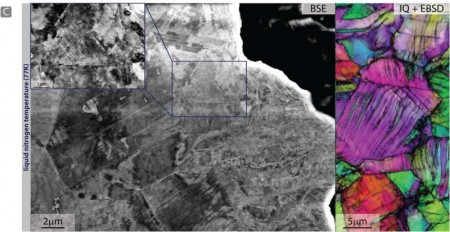Sep
9
The First Super Metal of the 21st Century
September 9, 2014 | 1 Comment
Lawrence Berkeley National Laboratory has released information about a new concept in metallic alloy design called “high-entropy alloys”. The multi-element high-entropy alloy not only tests out as one of the toughest materials on record, but, unlike most materials, the toughness as well as the strength and ductility of this alloy actually improves at cryogenic temperatures.
The multi-element alloy was synthesized and tested through a collaboration of researchers at the U.S. Department of Energy (DOE)’s Lawrence Berkeley and Oak Ridge National Laboratories (Berkeley Lab and ORNL).
Robert Ritchie, an internationally recognized authority on the mechanical behavior of materials with Berkeley Lab’s Materials Sciences Division said, “We examined CrMnFeCoNi, a high-entropy alloy that contains five major elements rather than one dominant one. Our tests showed that despite containing multiple elements with different crystal structures, this alloy crystallizes as a single phase, face-centered cubic solid with exceptional damage tolerance, tensile strength above one gigapascal, and fracture toughness values that are off the charts, exceeding that of virtually all other metallic alloys.”
To lay persons the metallurgy field seems quite slow moving with advancements coming as demands seek new materials. This announcement seems welcome now as more and more cryogenic handling and storage are going to be needed.
The tradition of mixing two metals together to create an alloy that possesses properties its constituent elements individually lack goes back thousands of years. In the 4th millennium BC, people began adding tin, a hard metal, to copper, a soft and relatively easy to work metal, to produce bronze, an alloy much stronger than copper. It was later discovered that adding carbon to iron yields the much stronger steel, and the addition of nickel and chromium to the mix yields steel that resists corrosion. Traditional alloys invariably feature a single dominant constituent with minor elements mixed in, and often rely on the presence of a second phase for mechanical performance.
Ritchie continues, “High-entropy alloys represent a radical departure from tradition in that they do not derive their properties from a single dominant constituent or from a second phase. The idea behind this concept is that configurational entropy increases with the number of alloying elements, counteracting the propensity for compound formation and stabilizing these alloys into a single phase like a pure metal.”
Although high-entropy alloys have been around for more than a decade, it has only been recently that the quality of these alloys has been sufficient for scientific study. George and his research group at ORNL combined high-purity elemental starting materials with an arc-melting and drop-casting process to produce high quality samples of CrMnFeCoNi (chromium, manganese, iron, cobalt and nickel) in sheets roughly 10 millimeters thick. After characterizing these samples for tensile properties and microstructure, the ORNL team sent them to Ritchie and his research group for fracture and toughness characterization.
Ritchie points out the importance of the new alloys in fuel storage with, “As high entropy alloys are single phase, we reasoned that they would be ideal for cryogenic applications, such as storage tanks for liquefied natural gas, hydrogen and oxygen. Our work is the first in-depth study that characterizes the fracture toughness properties of this class of alloys, and lo and behold, they are spectacular!”
Tensile strengths and fracture toughness values were measured for CrMnFeCoNi from room temperature down to 77 Kelvin, the temperature of liquid nitrogen. The values recorded were among the highest reported for any material. That these values increased along with ductility at cryogenic temperatures is a huge departure from the vast majority of metallic alloys, which lose ductility and become more brittle at lower temperatures.
Ritchie and George believe that the key to CrMnFeCoN’s remarkable cryogenic strength, ductility and toughness is a phenomenon known as “nano-twinning,” in which during deformation, the atomic arrangements in adjacent crystalline regions form mirror images of one another.
“These nano-twins are created when the material undergoes plastic deformation at cryogenic temperatures,” Ritchie says. “This represents a mechanism of plasticity in addition to the planar-slip dislocation activity most metals undergo at ambient temperatures. The result of nano-twinning deformation is a continuous strain hardening, which acts to suppress the localized deformation that causes premature failure.”
Ritchie noted that the mechanical properties of CrMnFeCoNi and other high-entropy alloys have yet to be optimized. “These high-entropy alloys may well be capable of even better properties,” he said.
Its interesting to see the new material appear just as the need for transporting cryogenically liquefied natural gas becoming a vital factor in the free world’s energy distribution system.
With Putinism busily disrupting the world’s established rules of national conduct putting the EU”s economy at risk from natural gas supply disruptions and the immense amounts of natural gas simply being lost to flaring off, this technology can’t get to commercial scale quickly enough.
Comments
1 Comment so far



Does it make superior swords? Inquiring minds want to know.